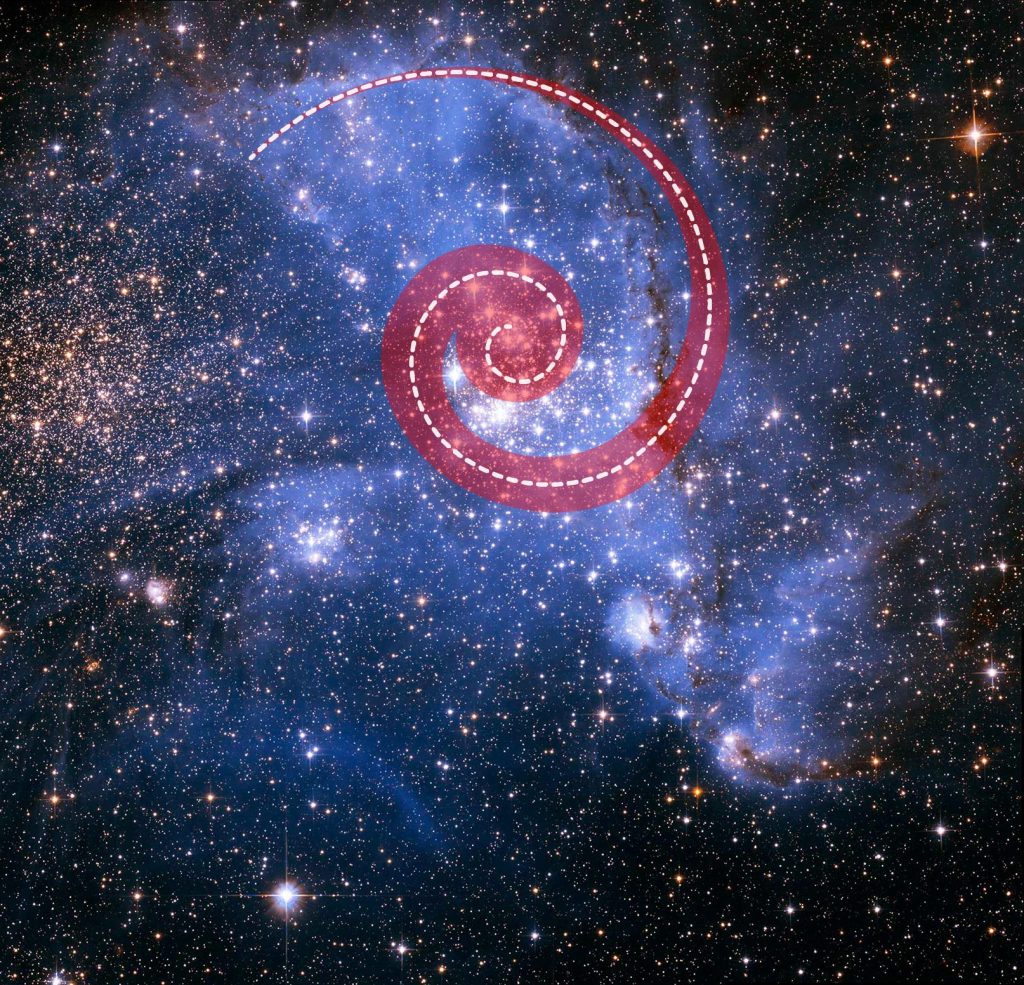
Der massereiche Sternhaufen NGC 346 in der Kleinen Magellanschen Wolke fasziniert Astronomen seit langem mit seiner ungewöhnlichen Form. Mit zwei getrennten Methoden haben die Forscher nun festgestellt, dass diese Form teilweise auf Sterne und Gas im Zentrum dieses Haufens zurückzuführen ist, die in einer flussähnlichen Bewegung aufsteigen. Die rote Spirale auf NGC 346 verfolgt die Bewegung von Sternen und Gas in Richtung Zentrum. Wissenschaftler sagen, dass diese Spiralbewegung der effizienteste Weg ist, um die Sternentstehung von außen zum Massenzentrum hin zu fördern. Bildnachweis: NASA, ESA und Andi James (STScI)
Sterne sind die Maschinen, die das Universum formen, doch die Forscher wissen immer noch nicht genau, wie sie entstehen. Wissenschaftler wandten sich der Kleinen Magellanschen Wolke zu, einer Galaxie, die dazugehört[{“ attribute=““>Milky Way, to understand the frenzied “baby boom” of star birth that occurred early in the universe’s history. This nearby galaxy has a simpler chemical composition than the Milky Way, which makes it similar to the galaxies found in the younger universe, when heavier elements were less abundant. As a result, it can serve as a proxy for the early universe.
Two separate research studies – the first with the Hubble Space Telescope, and the second with the European Southern Observatory’s Very Large Telescope – recently arrived at the same conclusion. Using different techniques, the independent teams discovered young stars spiraling into the center of a massive star cluster called NGC 346 in the Small Magellanic Cloud. This river-like motion of gas and stars is an efficient way to fuel star birth, astrophysicists say. The teams’ results demonstrate that the process of star formation in the Small Magellanic Cloud is similar to that in our own Milky Way.

The massive star cluster NGC 346, located in the Small Magellanic Cloud, has long intrigued astronomers with its unusual shape. Now researchers using two separate methods have determined that this shape is partly due to stars and gas spiraling into the center of this cluster in a river-like motion. Credit: NASA, ESA, Andi James (STScI)
NASA’s Hubble Finds Spiraling Stars, Providing Window into Early Universe
Spirals are prevalent in nature — from the whirlpool of a hurricane, to pinwheel-shaped protoplanetary disks around newborn stars, to the vast realms of spiral galaxies across our universe.
Now astronomers are bemused to discover young stars that are spiraling into the center of a massive cluster of stars in the Small Magellanic Cloud, a satellite galaxy of the Milky Way.
The outer arm of the spiral in this massive, oddly shaped stellar nursery called NGC 346 may be feeding star formation in a river-like motion of gas and stars. Scientists say that this is an efficient way to fuel star birth.
The Small Magellanic Cloud has a simpler chemical composition than the Milky Way. This makes it similar to the galaxies found in the younger universe when heavier elements were more scarce. Because of this, the stars in the Small Magellanic Cloud burn hotter and therefore run out of their fuel faster than in our Milky Way.
Even though it can serve as a proxy for the early universe, the Small Magellanic Cloud is also one of our closest galactic neighbors, at just 200,000 light-years away.
Discovering how stars form in the Small Magellanic Cloud offers a new twist on how a firestorm of star birth may have occurred early in the universe’s history, when it was undergoing a “baby boom” about 2 to 3 billion years after the big bang (the universe is now 13.8 billion years old).
According to the new findings, the process of star formation there is similar to that in our own Milky Way.
NGC 346 boasts the mass of 50,000 Suns, despite being only 150 light-years in diameter. Its intriguing shape and rapid star-formation rate have baffled astronomers. It required the combined power of NASA’s Hubble Space Telescope and the European Southern Observatory’s Very Large Telescope (VLT) to unravel the behavior of this mysterious-looking stellar nesting ground.
“Stars are the machines that sculpt the universe. We would not have life without stars, and yet we don’t fully understand how they form,” explained study leader Elena Sabbi of the Space Telescope Science Institute in Baltimore. “We have several models that make predictions, and some of these predictions are contradictory. We want to determine what is regulating the process of star formation, because these are the laws that we need to also understand what we see in the early universe.”
Scientists determined the motion of the stars in NGC 346 in two different ways. Using Hubble, Sabbi and her team measured the changes in the stars’ positions over 11 years. The stars in this region are moving at an average velocity of 2,000 miles per hour, resulting in a movement of 200 million miles in 11 years. This is about twice the distance between the Sun and the Earth.
However, this cluster is relatively far away, inside a neighboring galaxy. This means the amount of observed motion from our vantage point is very small and therefore difficult to measure. These extraordinarily precise observations were possible only because of Hubble’s outstanding resolution and high sensitivity. Additionally, Hubble’s three-decade-long history of observations provides a baseline for astronomers to follow minute celestial motions over time.
The second team, led by Peter Zeidler of AURA/STScI for the European Space Agency (ESA), used the ground-based VLT’s Multi Unit Spectroscopic Explorer (MUSE) instrument to measure radial velocity, which determines whether an object is approaching or receding from an observer.
“What was really amazing is that we used two completely different methods with different facilities and basically came to the same conclusion, independent of each other,” said Zeidler. “With Hubble, you can see the stars, but with MUSE we can also see the gas motion in the third dimension, and it confirms the theory that everything is spiraling inwards.”
But why a spiral?
“A spiral is really the good, natural way to feed star formation from the outside toward the center of the cluster,” explained Zeidler. “It’s the most efficient way that stars and gas fueling more star formation can move towards the center.”
Half of the Hubble data for this study of NGC 346 is archival, with the first observations taken 11 years ago. These observations were recently repeated to trace the motion of the stars over time. Given the telescope’s longevity, more than 32 years of astronomical data are now contained in the Hubble data archive, which can power unprecedented, long-term studies.
“The Hubble archive is really a gold mine,” said Sabbi. “There are so many interesting star-forming regions that Hubble has observed over the years. Given that Hubble is performing so well, we can actually repeat these observations. This can really advance our understanding of star formation.”
The teams’ findings appear today (September 8) in The Astrophysical Journal.
Reference: “The Internal Line-of-Sight Kinematics of NGC 346: The Rotation of the Core Region” by Peter Zeidler, Elena Sabbi and Antonella Nota, 8 September 2022, The Astrophysical Journal.
DOI: 10.3847/1538-4357/ac8004
Observations with NASA’s James Webb Space Telescope should be able to resolve lower-mass stars in the cluster, giving a more holistic view of the region. Over Webb’s lifespan, astronomers will be able to repeat this experiment and measure the motion of the low-mass stars. They could then compare the high-mass stars and the low-mass stars to finally learn the full extent of the dynamics of this nursery.
The Hubble Space Telescope is a project of international cooperation between NASA and ESA. NASA’s Goddard Space Flight Center in Greenbelt, Maryland, manages the telescope. The Space Telescope Science Institute (STScI) in Baltimore, Maryland conducts Hubble science operations. STScI is operated for NASA by the Association of Universities for Research in Astronomy, in Washington, D.C.

„Pop-Kulturaholic. Web-Nerd. Engagierter Social-Media-Praktiker. Reisefanatiker. Schöpfer. Food-Guru.“

/cdn.vox-cdn.com/uploads/chorus_asset/file/24924650/236780_Google_AntiTrust_Trial_Custom_Art_CVirginia__0000_4.png)




More Stories
Die Federal Aviation Administration fordert eine Untersuchung des Misserfolgs bei der Landung der Falcon-9-Rakete von SpaceX
Identische Dinosaurier-Fußabdrücke auf zwei Kontinenten entdeckt
SpaceX startet 21 Starlink-Satelliten mit einer Falcon 9-Rakete von Cape Canaveral aus – SpaceflightNow